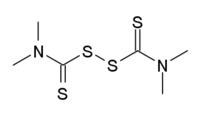Thiram
 | |
| Names | |
|---|---|
| IUPAC name
dimethylcarbamothioylsulfanyl N,N-dimethylcarbamodithioate | |
| Identifiers | |
| ATC code | P03 |
| 137-26-8 | |
| ChEBI | CHEBI:9495 |
| ChemSpider | 5256 |
| |
| Jmol-3D images | Image |
| KEGG | D06114 |
| PubChem | 5455 |
| |
| Properties | |
| Molecular formula |
C6H12N2S4 |
| Molar mass | 240.43 g·mol−1 |
| Appearance | White to yellow crystalline powder |
| Melting point | 155 °C (311 °F; 428 K) |
| 30 mg/L | |
| Hazards | |
| Flash point | 138 °C (280 °F)[1] |
| US health exposure limits (NIOSH): | |
| PEL (Permissible) |
TWA 5 mg/m3[2] |
| Except where noted otherwise, data is given for materials in their standard state (at 25 °C (77 °F), 100 kPa) | |
| | |
| Infobox references | |
Thiram is a fungicide, ectoparasiticide, and animal repellent. It is used to prevent fungal diseases in seed and crops. It is also used as an animal repellent to protect fruit trees and ornamentals from damage by rabbits, rodents and deer. It is effective against Stem gall of coriander, damping off, smut of millet, neck rot of onion, etc. Thiram has been used in the treatment of human scabies, as a sun screen and as a bactericide applied directly to the skin or incorporated into soap.[3]
Chemical properties
Thiram is a type of sulfur fungicide. It has been found to dissolve completely in chloroform, acetone and ether. It is available as dust, flowable, wettable powder, water dispersible granules, and water suspension formulations and in mixtures with other fungicides.[3]
Thiram is nearly immobile in clay soils or in soils of high organic matter. It is not expected to contaminate groundwater because of its in-soil half life of 15 days and tendency to stick to soil particles.[4]
As a waste, Thiram carries an EPA U244 code.
Acute toxicity
Thiram is moderately toxic by ingestion, but it is highly toxic if inhaled. Acute exposure in humans may cause headaches, dizziness, fatigue, nausea, diarrhea and other gastrointestinal complaints.[5]
Thiram is irritating to the eyes, skin and respiratory tract. It is a skin sensitizer. Symptoms of acute inhalation exposure to thiram include itching, scratchy throat, hoarseness, sneezing, coughing, inflammation of the nose or throat, bronchitis, dizziness, headaches, fatigue, nausea, diarrhea and other gastro-intestinal complaints. Persons with chronic respiratory or skin disease are at increased risk from exposure to thiram.
Chronic toxicity
In addition to the symptoms of acute exposure, symptoms of chronic exposure to thiram in humans include drowsiness, confusion, loss of sex drive, incoordination, slurred speech and weakness. Repeated or prolonged exposure to thiram can also cause allergic reactions such as dermatitis, watery eyes, sensitivity to light and conjunctivitis.[6]
Metabolic effects
Thiram has been described to interfere with glucocorticoid metabolism, by inhibiting the activity of the enzyme 11beta-hydroxysteroiddehydrogenase type 2, which converts cortisol to cortisone.[7]
References
- ↑ U.S. Department of Agriculture, Soil Conservation Service. 1990 (Nov). SCS/ARS/CES Pesticide Properties Database: Version 2.0 (Summary). USDA - Soil Conservation Service, Syracuse, NY.
- ↑ "NIOSH Pocket Guide to Chemical Hazards #0612". National Institute for Occupational Safety and Health (NIOSH).
- ↑ 3.0 3.1 "Thiram". Extension Toxicology Network.
- ↑ Howard, P.H., ed. (1989). Handbook of Environmental Fate and Exposure Data for Organic Chemicals. Vol. III: Pesticides. Chelsea, MI: Lewis Publishers.
- ↑ Hayes, W.J. and E.R. Laws, ed. (1990). Handbook of Pesticide Toxicology. Vol. 3, Classes of Pesticides. NY: Academic Press, Inc.
- ↑ CDC - NIOSH Pocket Guide to Chemical Hazards
- ↑ Atanasov, Atanas G; Tam, Steven; Röcken, Jens M; Baker, Michael E; Odermatt, Alex (2003). "Inhibition of 11β-hydroxysteroid dehydrogenase type 2 by dithiocarbamates". Biochemical and Biophysical Research Communications 308 (2): 257–62. doi:10.1016/S0006-291X(03)01359-7. PMID 12901862.
| ||||||||||||||||||||||||||||||||||||||||||||||||||||||||||||||||
External links
- Thiram in the Pesticide Properties DataBase (PPDB)